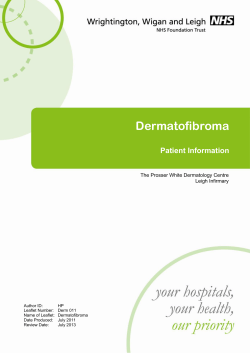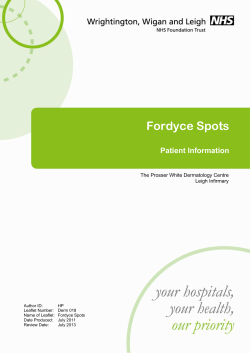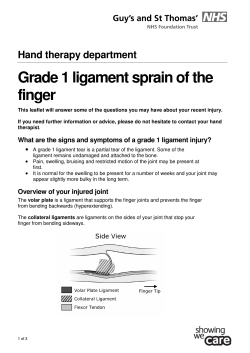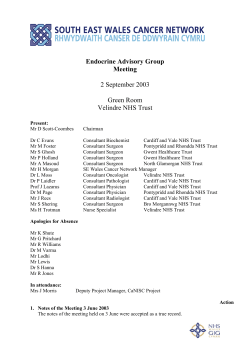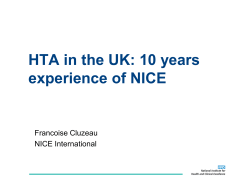
B07/S/e 2013/14 NHS STANDARD CONTRACT FOR BONE AND JOINT INFECTION SERVICE SPECIFICATION
B07/S/e 2013/14 NHS STANDARD CONTRACT FOR BONE AND JOINT INFECTION SERVICE SPECIFICATION (ADULT) SECTION B PART 1 - SERVICE SPECIFICATIONS Service Specification No. Service Commissioner Lead Provider Lead Period Date of Review B07/S/e Bone and Joint Infections (Adult) 12 months 1. Population Needs 1.1 National/local context and evidence base National context: The management of complex bone and joint infection would be best serviced by 3-6 networks nationally each with a specialist centre. Bone and Joint infections that are complex and require a specialist centre with specific multidisciplinary team expertise include the following conditions: 1. Chronic community-acquired, post-trauma, or healthcare-associated ‘native’ joint or bone infections (with no orthopaedic metalware present): • Osteomyelitis (bone infection) involving long bones • Septic arthritis (joint infection) with joint destruction • Complex pelvic osteomyelitis often secondary to pressure sores 2. Chronic post-operative orthopaedic device related infections (with orthopaedic metalware present): • Artificial joint and bone infections of joint replacements (performed for arthritis or bone/soft tissue tumours) • Infected un-united fractures • Infected implants with healed fractures These cases have historically been managed in local or regional centres. Nonspecialist treatment at times leads to multiple, often unsuccessful, procedures and 1 © NHS Commissioning Board, 2013 The NHS Commissioning Board is now known as NHS England NHS England B07/S/e medical therapies. For the patient this results in very long hospital stays, considerable pain and disability. In addition there is high cost to the NHS. Infection or colonisation with multi-resistant organisms results in costly isolation precautions, a risk of transmission to others (causing outbreaks and bed closures) and the need for expensive antibiotics. Patients may have purulent discharging wounds with offensive odour adding to severe emotional stress in addition to physical illness. Without specialist intervention, local clinicians may resort to limb amputations, or suggest the patient is untreatable. Failure of treatment leads to loss of mobility, loss of employment, significant long term home care needs, and on occasion, uncontrolled infection and death. In category (1) above, long bone osteomyelitis, septic arthritis, and pelvic osteomyelitis often occur in young adults resulting in a major effect on their quality of life and productivity. Both groups may include military personnel with conflict wounds that have gone on to develop chronic infections. All require highly specialist orthopaedic surgery to debride infected bone and soft tissues and then to reconstruct the area. It is crucial to perform highly specialised orthopaedic surgery but also to match this with a skilled soft tissue reconstruction, an accurate microbiological diagnosis and correct antibiotic delivery (agent, route of administration and duration) and all delivered simultaneously. In category (2) above; post-operative infections, such as infections of joint replacements, are often managed initially by the orthopaedic surgeon who did the primary implantation. As most orthopaedic surgeons have an infection rate of around 1% for their elective procedures1, management of infection may not be part of their surgical expertise. They are unlikely to have easy access to specialist infection advice and plastic surgical input. Local attempts at intervention such as early joint debridements or revisions may be unsuccessful and lead to delayed referral to a specialist centre. Salvage of the joint is then much harder due to bone damage, development of resistant organisms and deterioration of the general physical and emotional state of the patient. Disease prevalence: In England alone there are around 250,000 bone operations including 60,000 hip replacements performed annually2. In the case of prosthetic joints; around 1% of these become infected. This results in 600 new prosthetic hip infections per year. As infection may remain unresolved for several years the prevalence of infection is higher. A proportion will become more complex (i.e. patients have multiple medical co-morbidities and/or difficult to treat/multi-resistant organisms and/or failure of treatment locally and/or multiply operated joint with ongoing infection). In the UK, the management of fractures has moved from conservative treatment to operative fixation with metalwork. In open fractures, infection may complicate up to 25% of cases producing an increasing challenge for orthopaedic reconstruction services. Poor or delayed care in these cases will result in amputation with lifelong disability. 2 © NHS Commissioning Board, 2013 The NHS Commissioning Board is now known as NHS England NHS England B07/S/e References http://www.hpa.org.uk/Publications/InfectiousDiseases/SurgicalSiteInfectio nReports/1112SSIreport2010data/ http://www.hesonline.nhs.uk/Ease/servlet/ContentServer?siteID=1937&categoryID= 204 British Association of Plastic, Reconstructive and Aesthetic Surgeons (BAPRAS)/British Orthopaedic Association (BOA) standards for the management of open fractures of the lower limb 2009. Sept 2009. http://www.bapras.org.uk/downloaddoc.asp?id=141 Evidence base There is good evidence and a strong view from NICE, the NHS Institute for Innovation and Improvement and other groups that multidisciplinary team working improved outcomes in health care. A clear examples is cancer services1,2 but it has also been applied to osteomyelitis 3,4 and other chronic infections such as diabetic foot infections and spinal infections 5-8 • Chronic bone and joint infections have many similarities with cancer – i.e. the condition is usually painful, disabling, may require resection surgery and reconstruction, long term vascular access, chemotherapy (antibiotics), specialist in-patient and community nursing care, rehabilitation facilities and access to psychological support. The evidence base, guidelines, targets and funding streams for bone and joint infection are, as yet, less well defined than with cancer, as it is a new and growing area of healthcare need. Development of multidisciplinary expertise lags behind the major expansion in the use of complex orthopaedic devices over the past four decades. • The annual number of international publications and meetings on bone and joint infections has increased significantly in the past five years. There are many reviews 9-14 but no guideline documents or standards. The lack of guidance has been recognised so The British Orthopaedic Association and British Infection Association have recently convened a working party to develop national clinical guidelines. The Infectious Diseases society of America is about to publish clinical guidelines on the management of prosthetic joint infection 15 References 1. .http://www.nice.org.uk/guidance/qualitystandards/breastcancer/Multidisciplinar yTeam.jsp 2. Stephens MR, Lewis WG, Brewster AE, Lord I, Blackshaw GR, Hodzovic I, Thomas, GV, Roberts SA, Crosby TD, Gent C, Allison MC, Shute K. Multidisciplinary team management is associated with improved outcomes after surgery for esophageal cancer. Dis Esophagus. 2006;19(3):164-71. 3. Ziran BH, Rao N, Hall RA. A dedicated team approach enhances outcomes of osteomyelitis treatment. Clin Orthop Relat Res. 2003 Sep;(414):31-6. 4. Salvana J, Rodner C, Browner BD, Livingston K, Schreiber J, Pesanti E. Chronic osteomyelitis: results obtained by an integrated team approach to management. Conn Med. 2005 Apr;69(4):195-202. 3 © NHS Commissioning Board, 2013 The NHS Commissioning Board is now known as NHS England NHS England B07/S/e 5. Watts SA, Gee J, O'Day ME, Schaub K, Lawrence R, Aron D, Kirsh S. Nurse practitioner-led multidisciplinary teams to improve chronic illness care: the unique strengths of nurse practitioners applied to shared medical appointments/group visits. J Am Acad Nurse Pract. 2009 Mar;21(3):167-72. 6. Gasbarrini A, Boriani L, Nanni C, Zamparini E, Rorato G, Ghermandi R, Salvadori C, Allegri V, Bandiera S, Barbanti-Brodano G, Colangeli S, Corghi A, Terzi S, Babbi L, Amendola L, Cristini F, Marinacci G, Tumietto F, Ciminari R, Malaguti MC, Rimondi E, Difiore M, Bacchin R, Facchini F, Frugiuele J, Morigi A, Albisinni U, Bonarelli S, Fanti S, Viale P, Boriani S. Spinal infection multidisciplinary management project (SIMP): from diagnosis to treatment guideline. Int J Immunopathol Pharmacol. 2011 Jan-Mar;24(1 Suppl 2):95-100. 7. Darbellay P, Uçkay I, Dominguez D, Mugnai D, Filtri L, Lew D, Assal M. [Diabetic foot infection: a multidisciplinary approach]. Rev Med Suisse. 2011 Apr 27;7(292):894-7. French. Erratum in: Rev Med Suisse. 2011 Aug 10;7(304):1559. 8. Lipsky BA, Berendt AR, Cornia PB, Pile JC, Peters EJ, Armstrong DG, Deery HG, Embil JM, Joseph WS, Karchmer AW, Pinzur MS, Senneville E. 2012 Infectious Diseases Society of America clinical practice guideline for the diagnosis and treatment of diabetic foot infections. Clin Infect Dis. 2012 Jun;54(12):e132-73. 9. Moran E, Byren I, Atkins BL. The diagnosis and management of prosthetic joint infections. J Antimicrob Chemother. 2010 Nov;65 Suppl 3:iii45-54. 10. Zimmerli W, Trampuz A, Ochsner PE. Prosthetic-joint infections N Engl J Med. 2004 Oct 14;351(16):1645-54 11. Stockley I, Mockford BJ, Hoad-Reddick A, Norman P. The use of two-stage exchange arthroplasty with depot antibiotics in the absence of long-term antibiotic therapy in infected total hip replacement. J Bone Joint Surg Br. 2008 Feb;90(2):145-8. 12. Sukeik M, Haddad FS.Two-stage procedure in the treatment of late chronic hip infections--spacer implantation. Int J Med Sci. 2009 Sep 2; 6(5):253-7. 13. One hundred and twelve infected arthroplasties treated with ‘DAIR’ (debridement, antibiotics and implant retention): antibiotic duration and outcome. I. ByrenP. Bejon, B. L. Atkins, B. Angus, S. Masters, P. McLardySmith, R. Gundle, A. Berendt. J Antimicrobial Chemo. 2009. 14. Two-stage revision for prosthetic joint infection: predictors of outcome and the role of reimplantation microbiology. P. Bejon, A. Berendt, B. L. Atkins, N. Green, H. Parry, S. Masters, P. Mclardy-Smith, R. Gundle, I. Byren. J Antimicrob Chemother 2010; 65: 569–575 15. http://www.idsociety.org/Organ_System/#Skeletal%20(Bones%20&%20Joi nts) 4 © NHS Commissioning Board, 2013 The NHS Commissioning Board is now known as NHS England NHS England B07/S/e 2. Scope 2.1 Aims and objectives of service The bone and joint infection service will accept appropriate secondary and tertiary adult referrals from across the UK. The referrals will come from orthopaedic surgeons, infection physicians and primary care physicians (as determined by the commissioners). Patients will include those with: • Chronic pelvic osteomyelitis (including after pressure ulceration), • Chronic osteomyelitis (e.g. of long bone) • Chronic destructive septic arthritis • Complex prosthetic joint infections (i.e. Patients with multiple medical comorbidities and/or difficult to treat/multi-resistant organisms and/or failure of treatment locally and/or multiply operated joint with ongoing infection • Infected fracture non-unions • Infected fracture fixation implants (healed fracture) Core objectives should include: • Resolution of infection with minimum possible antibiotic use • Restoration of function and return to more independent living with greater quality of life measures • Avoidance of infection-related death, limb loss, morbidity and adverse patient experience • Reduced length of hospital stay • Development of enhanced diagnostic and treatment pathways and dissemination of these to other relevant centres and networks These will be achieved through: • Timely admission and one-stop multi-disciplinary review of patients requiring inpatient assessment. • Timely one-stop multidisciplinary team review and investigation of patients requiring outpatient assessment • Appropriate orthopaedic surgery in the same episode as appropriate soft tissue reconstruction and appropriate tissue sampling and antimicrobial administration. • Systematic collection of outcome measures 2.2 Service description/care pathway Key principles Clinical • Patients achieve better outcomes from access to technically skilled surgeons 5 © NHS Commissioning Board, 2013 The NHS Commissioning Board is now known as NHS England NHS England B07/S/e • • • • • • • specialising in bone and joint infection and a full multi-disciplinary team to support them. The patient experience is improved with more timely referral and treatment. The patient experience is much improved by one stop combined clinics and single ortho-plastic surgical procedures. The patient experience is improved with more experienced staff and peer support. Complication rates from surgery and antibiotic treatment are reduced through expertise in units dealing with high numbers of patients. Unnecessary hospital stays, investigations, antibiotic usage are avoided. The unit will have antimicrobial stewardship measures in place to ensure appropriate use of antibiotics and avoidance of complications (e.g. C.difficile), antimicrobial resistance and cost. Patient experience will be improved by earlier discharge from hospital with an Outpatient Parenteral Antimicrobial Therapy (OPAT) service. Research • Audit, epidemiological, management and outcome data will be collected. • It will lead research into diagnostic pathways, surgical methods, antibiotic duration and delivery and service improvements (such as self administration of antibiotics at home and patient held records). Education • Specialist centres will run educational meetings for orthopaedic surgeons, infection specialists and primary care physicians. A national forum/conference would occur annually – contributed to by all designated centres, (possibly in rotation). • It will welcome clinical observers including those from such collaborative schemes run though the European Society of Clinical Microbiology and Infectious Diseases (ESCMID) and European Federation of Orthopaedics and traumatology (EFORT) • It will lead/participate in national guidelines for the prevention and management of bone and joint infection Health Economics • The clinical, educational and research principles above will favour savings to Health Care Delivery • Avoidance of recurrent infection with inadequate treatment will reduce whole system costs Components Key components for a bone infection unit include day-to-day access to the following: • Combined in-patient and out-patient care with input from the following specialties: • Orthopaedic surgeons who specialise in complex bone and joint infection (e.g. long bone reconstructive surgeons, complex joint revision surgeons) • Infection physicians experienced in dealing with medically unwell 6 © NHS Commissioning Board, 2013 The NHS Commissioning Board is now known as NHS England NHS England B07/S/e • • • • • • • • • • patients, chronic medical co-morbidities, interpretation if microbiology, histology and radiology results, treatment of multi-resistant bacteria, tuberculosis and other difficult organisms, antimicrobial management and Outpatient Parenteral Antimicrobial Therapy (OPAT). • Plastic surgeons specialising in the management of soft tissues in associated with bone and joint infections Microbiological, histopathological and radiological diagnostics for musculoskeletal infection A service for administering intravenous antibiotics at home safely (OPAT) Dedicated in-patient beds staffed by specialist nurses and professionals allied to medicine which include the following: • Pain management team • Occupational therapists • Physiotherapists • Dietician • Clinical nurse specialists (e.g. Trained in ilizarov method, tissue viability) • Pharmacist with an interest in infection and antimicrobial stewardship Multidisciplinary (combined) outpatient clinics Scheduled (at least weekly) multidisciplinary meetings (including radiologist, orthopaedic surgeons, plastic surgeons and infection physicians) to assess referrals and discuss management plans. Daily multidisciplinary triage of all referrals for in-patients in other trusts and/or urgent outpatients. Access to other specialist services including intensive care, vascular surgery, gastrointestinal surgery, haemophilia, HIV, psychology, psychiatric services, social services, rheumatology and rehabilitation, ortho-geriatrics, prosthetics and orthotics. A clinical governance structure and service lead Quality measures: patient experience surveys, clinical outcome measures (such as arrest of infection, pain measures, ambulation and function of the patient) Potential network links with bone tumour, spinal and trauma services. The clinical or care pathway may be available or referenced at the Map of Medicine website http://www.mapofmedicine.com/ or NICE http://pathways.nice.org.uk/ although some of these are more detailed for the less specialised part of the pathway. A more detailed description of the key interventions that make up the service and its position in the wider care pathway can be added where it is considered important to ensure the delivery of key service objectives or as a proxy for improved clinical outcomes. It may also include reference to the services defined in the SSNDS. See separate document (Appendix: Clinical pathway) 7 © NHS Commissioning Board, 2013 The NHS Commissioning Board is now known as NHS England NHS England B07/S/e 2.3 Population covered The service outlined in this specification is for patients ordinarily resident in England*; or otherwise the commissioning responsibility of the NHS in England (as defined in Who pays?: Establishing the responsible commissioner and other Department of Health guidance relating to patients entitled to NHS care or exempt from charges). Specifically, this service is for adults with an infectious disease requiring specialised intervention and management, as outlined within this specification. Note: for the purposes of commissioning health services, this EXCLUDES patients who, whilst resident in England, are registered with a GP Practice in Wales, but INCLUDES patients resident in Wales who are registered with a GP Practice in England. Legislation for Scotland and Northern Ireland provides that the responsible authority for an individual’s healthcare provision is the one where a person is usually resident and is not based on GP practice registration as provided by English legislation. The service is aimed at adults of all ages with chronic osteomyelitis, chronic septic arthritis, pelvic osteomyelitis relating to pressure sores, infected fracture non- unions, prosthetic joint infection, those with multi-resistant or difficult to treat organisms and those bone and joint infections requiring surgical intervention who have multiple medical co-morbidities. Eligible patient groups include all adults with these conditions. This also includes a patient group from the military medical services who present with bone and joint infections, principally after high-energy trauma with complex infections with multi-resistant organisms and major reconstruction challenges. Usually the patient would have been seen by another medical professional and be identified as having a complex bone or joint infection as described above and requiring multidisciplinary medical/surgical care. Referral can be from orthopaedic, infectious disease, plastics or primary care doctors in centres across the UK as determined by the commissioning group. . 2.4 Any acceptance and exclusion criteria The unit will comply with local and national polices, guidelines and other conditions of commissioning as required (including, but not limited to, mandatory surveillance systems, antimicrobial stewardship, governance, patient safety alerts and NICE). 2.5 Interdependencies with other services Critical links • Intensive care, general medicine, general surgery • Vascular surgery • Gastro-intestinal surgery 8 © NHS Commissioning Board, 2013 The NHS Commissioning Board is now known as NHS England NHS England B07/S/e • • • • • Psychiatric services Rheumatology and rehabilitation Diabetic services Ortho-geriatrics o Social services o Prosthetics Orthotics. Desirable links • HIV medicine • Haemophilia centre • Psychological services Other centres • Repatriation arrangements back to source hospitals for further rehabilitation. • Rehabilitation centre for specific patients e.g. military or police • wheelchair services 3. Applicable Service Standards 3.1 Applicable national standards e.g. NICE, Royal College • • NICE quality standard: Patient experience in adult NHS services http://www.nice.org.uk/guidance/qualitystandards/patientexperience/home.jsp Patient experience in adult NHS services. NICE clinical guideline 138 (2012). Available from http://guidance.nice.org.uk/CG138 There are several NICE guidelines that may be relevant to certain patient groups. These include: • The management of pressure ulcers in primary and secondary care, 2005 • Nutrition support in adults: 2006 • Venous thrombo-embolic disease: 2012 The lack of standards specifically in in bone and joint infection has been recognised. Hence the formation of a British Orthopaedic Association and British Infection Association working party to develop such guidelines. 4. Key Service Outcomes Outcomes: Clinical • Clinical infection recurrence rate • Post-operative complication rate. • Reoperation rate • Readmission rate 9 © NHS Commissioning Board, 2013 The NHS Commissioning Board is now known as NHS England NHS England B07/S/e • • • • Functional outcomes with 1 and 5 year follow ups assessed by ASAMI bone and function scores. Amputation rate in prosthetic joint infections, chronic osteomyelitis and infected non-unions Mortality (30 day and 1 year) Process • Length of stay • Access to care (waiting times, failure to attend appointment rates, adherence to “one- stop shop” principle). • Number of complaints and time to response/resolution • Rates of unplanned transfers to acute specialities such as general medicine, general surgery or intensive care It would be possible to develop a national registry for bone and joint infection to provide information on epidemiology, microbiological isolates and treatment outcomes in patient-specific groups. This will inform future design on quality accounts in bone infection management. Access to care • • • • • • • • • In-patients in other trusts; • Acute management (e.g. drainage of pus, stabilisation of patient, intensive therapy unit care) done locally (telephone advice available from specialist centre) • Sub-acute and chronic infections: triage decision and transfer for multidisciplinary team in-patient or out-patient assessment within 7 days of referral Out-patient referrals • Progressive, unstable infection: triage decision and multidisciplinary team in-patient or out-patient assessment within 14 days of referral • Chronic infection: multidisciplinary team out-patient review within 8 weeks of referral Surgery • Chronic infections: 100% have received operations (if required) within 18 weeks Clinic letters sent out within 96 hours of appointment 100% compliance with NICE guidance on VTE prophylaxis MRSA and C.difficile rates within Department of Health targets 100% compliance with Waterlow and MUST score assessments Complaints Unplanned transfers to acute specialities such as general medicine, general surgery or intensive care It would be possible to develop a National Registry for bone and joint infection to provide information on epidemiology, microbiological isolates and treatment outcomes in patient-specific groups. This will inform future design on Quality Accounts in bone infection management 10 © NHS Commissioning Board, 2013 The NHS Commissioning Board is now known as NHS England NHS England B07/S/e 11 © NHS Commissioning Board, 2013 The NHS Commissioning Board is now known as NHS England NHS England B07/S/e
© Copyright 2025
